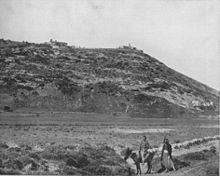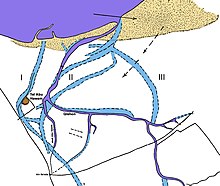This is an old revision of this page, as edited by 89.208.1.69 (talk) at 11:36, 11 December 2019 (→20th century: Added 1922 census information o). The present address (URL) is a permanent link to this revision, which may differ significantly from the current revision.
Revision as of 11:36, 11 December 2019 by 89.208.1.69 (talk) (→20th century: Added 1922 census information o)(diff) ← Previous revision | Latest revision (diff) | Newer revision → (diff)
The history of Haifa dates back to the 3rd century CE. Since then it has been controlled by several civilizations, including the Canaanites, Israelites, Romans, Byzantines, Arabs, Crusaders, Kurds, the Mamluks, the Ottoman Palestinians and it is currently a major city in Israel. Today, it is a mixed city of Jews and Palestinians (both Muslim and Christian) Arab citizens of Israel.
Early history


A small port city, Tell Abu Hawam, existed in the Haifa region in the Late Bronze Age (14th century BCE). The 6th-century BCE geographer Scylax describes a city "between the bay and the Promontory of Zeus" (i.e., the Carmel) which may be a reference to a settlement on the site of modern-day Haifa in the Persian period. The city moved to a new site south of what is now Bat Galim, in Hellenistic period, after the old port became blocked with silt. The archaeological site of Shikmona lies southwest of Bat Galim neighbourhood of Haifa. Mount Carmel and the Kishon River are also mentioned in the Bible. The geology of Mount Carmel has left the Mount riddled with caves. A grotto on the top of Mount Carmel is known as the "Cave of Elijah", traditionally linked to the Prophet Elijah and his apprentice, Elisha. In Arabic, the highest peak of the Carmel range is named El-Muhrrakah, or the "place of burning," harking back to the burnt offerings and sacrifices on this hilltop in Canaanite and early Israelite times It is believed that this was the point of Elijah's biblical confrontation with hundreds of priests of a Baal; the Baal in question was probably Melqart.
There are disputes over the exact location of early Haifa with many researchers believing that the name ‘Haifa’ is identical to a settlement of which the remains have been found in an area that extends from the present-day Rambam Hospital to the Jewish Cemetery in Yafo Street. The residents of this time were largely thought to have been involved in various coastal industries, including fishing and agriculture as well as acting as a port welcoming groups of people who eventually settled in the city. Before the Persians came to the area in 600 CE, the population of Haifa is thought to have been widely dispersed across the area.
The city is first mentioned in Talmudic literature around the 3rd century CE, as a small fishing village and the home of Rabbi Avdimos and other Jewish scholars. The hellenised population lived along the coast at this time was engaged in commerce. Haifa was located near the town of Shikmona, the main Jewish town in the area at that time and a center for making the traditional Tekhelet dye used for Jewish Priests' temple cloth
Under Byzantine rule, Haifa continued to flourish, although never grew to great importance due to its proximity to Acre.
Medieval era
Byzantine rule ended in the 7th century, when the city was conquered by the Persians, and then by the Arabs in the 640s. During early Arab rule, Haifa was largely overlooked in favor of the port city of 'Akka. Under the Rashidun Caliphate, the city began to develop and in the 9th century under the Abbasid Caliphate, Haifa established trade relations with Egyptian ports and the city contained several shipyards. The inhabitants, Arabs and Jews, engaged in trade and maritime commerce. Glass production and dye-making from marine snails were the city's most lucrative industries.
In 1100, it was conquered again by the crusaders, after a fierce battle with its Jewish inhabitants and Saracen garrison. Under crusader rule, the city was a part of the Principality of Galilee until the Muslim Mameluks captured it in 1265.
The Carmelites were founded at, and named after, Mount Carmel, in the 12th century. Since that time, at the peak of the Mount near Haifa, there has historically been a building that has variously been a mosque, monastery, and hospital; in the 19th century it was reconstructed as a Carmelite monastery, and a cave located there, which functions as the monastery's crypt, was treated as having once been Elijah's cave.
Ottoman era

In 1761 Zahir al-Umar, Arab ruler of Acre and Galilee, destroyed the old city of Haifa Called "Haifa El-Atika" and rebuilt the town in a new location, surrounding it with a wall. This event is marked as the beginning of the town's modern era. After Zahir's death in 1775, the town remained under Ottoman rule until 1918, except for two brief periods: in 1799, Napoleon Bonaparte conquered Haifa as part of his unsuccessful campaign to conquer Palestine and Syria, but withdrew in the same year; and between 1831 and 1840, the Egyptian viceroy Mehemet Ali governed, after his son Ibrahim Pasha wrested control from the Ottomans.
In the years following the Egyptian occupation, Haifa grew in population and importance while Acre suffered a decline. The arrival of the German Templers in 1868, who settled in what is now known as the German Colony of Haifa, was a turning point in Haifa's development. The Templers built and operated a steam-based power station, opened factories and inaugurated carriage service to Acre, Nazareth and Tiberias, playing a key role in modernizing the city.
It was in the late 19th century that the area rose to importance in the Bahá'í Faith as the remains of the Báb were moved initially to Acre and, in 1909, to Haifa where a special tomb was erected for this purpose on Mount Carmel by `Abdu'l-Bahá. Haifa remains an important site of worship, pilgrimage and administration for the members of the religion. The Bahá'í World Centre (comprising the Shrine of the Báb, terraced gardens and administrative buildings) are all on Mount Carmel's northern slope. The location of the Bahá'í holy places in Haifa has its roots in the exile of the religion's founder, Bahá'u'lláh, to the Haifa/'Akka area during Ottoman rule over Palestine. The Bahá'í holy places are also the most visited tourist attraction in Haifa.
In the early 20th century, early Ahmadi Muslims migrated to Kababir, a small suburb of Haifa, today consisting of Jews and Ahmadis. Over years the community developed and now acts as the Arab centre of the community. The community broadcasts its programmes to the Arab world via the MTA 3 channel from Haifa. Kababir is also known for its Mahmood mosque, a unique architectural landmark.
20th century
At the beginning of the 20th century, Haifa emerged as an industrial port city and a growing population center. The Hejaz railway and the Technion were established at that time. The Haifa District was home to approximately 72,850 Palestinians, 96 percent Palestinian Arab (82 percent Muslim and 14 percent Christian), and four percent Jewish. As Jewish illegal immigration increased, the balance shifted. By 1945 the population was 53 percent Arab (33 percent Muslim and 20 percent Christian) and 47 percent Jewish. The 1922 census recorded a population of 25,000 in Haifa, of whom more than 9,000 were Muslims, slightly fewer Christian Arabs, and more than 6,000 Jews. According to the 1931 census, it contained 50,403 residents, including about 20,000 Muslims, 15,923 Jews, and about 14,000 Christians. In 1947, the population comprised 70,910 Arabs (41,000 Muslims and 29,910 Christians) and 74,230 Jews. The Christians belong mostly to the Greek Orthodox Church (Arab Orthodox). Haifa was designated as part of the Jewish state in the 1947 UN Partition Plan that proposed dividing Mandate Palestine into two states. In December 1947 the Jewish militant group Irgun hurled two bombs at a group of Palestinian Arabs waiting for construction jobs outside the Consolidated Refineries in Haifa, killing 6 and injuring 42. Haifa's location was strategic as it was the country's major industrial port.
The British in Haifa redeployed on April 21, 1948, withdrawing from most of the city while still maintaining control over the port facilities. The city was occupied on April 23, 1948 by militias, the Carmeli Brigade of the Haganah who were ordered into action by Mordechai Maklef at 10:30 am on 21 April following three months of unsuccessful attacks by Arab forces. Most of the Palestinian Arab population was expelled and the city was ethnically cleansed. From over 270,000 only 3,300 Palestinians were still living in the city by June 1948. By the end of June, the remaining British forces left Haifa.
Today, Haifa has a population of about 266,300 people. Approximately 90% of the population consists of Israeli-Jews, predominantly those without religious classification and mostly immigrants from the former Soviet Union from mixed-marriage families of Jewish origin. According to the Israeli Central Bureau of Statistics, Israeli-Arabs constitute today only 9% of Haifa's population, the majority living in Wadi Nisnas, Abbas and Halisa neighborhoods.
See also
References
- ^ Encyclopedia Judaica, Haifa, Keter Publishing, Jerusalem, 1972, vol. 7, pp. 1134-1139
- "Two Tombstones from Zoar in the Hecht Museum Collection" (PDF). University of Haifa. Archived from the original (PDF) on 2008-02-26. Retrieved 2008-01-25.
- ^ 1 Kings 19:9
- "Kishon". HighBeam Encyclopedia (Colombia Encyclopedia). Retrieved 2008-03-20.
- http://bahai-library.com/ullian_israel_haifa
- ^ "Old Haifa". Tour-Haifa.co.il. Archived from the original on 2008-04-15. Retrieved 2008-01-20.
- "Haifa". Jewish Virtual Library. Retrieved 2008-01-20.
- "The History and Culture of the Canaanites and Phoenicians". Archived from the original on 2007-10-12. Retrieved 2008-04-09.
- Haifa, The Guide to Israel, Zev Vilnay, Jerusalem, 1970, p.382
- Negev, Avraham; Gibson, Shimon. Archaeological Encyclopedia of the Holy Land. Continuum International Publishing Group. p. 213. ISBN 978-0-8264-8571-7.
- Clifford Edmund Bosworth (2007). Historic cities of the Islamic world (Illustrated ed.). BRILL. pp. 149–151. ISBN 9789004153882. Retrieved 2011-07-02.
- The City of Haifa: Historical Perspective. The Haifa Foundation
- Carmel, Alex (2002). The History of Haifa Under Turkish Rule (4th ed.). Haifa: Pardes. p. 14. ISBN 965-7171-05-9. (translated from Hebrew)
- "Haifa in the Middle Ages". Tour-Haifa.co.il. Retrieved 2008-02-15.
- "ORIGINS OF THE CARMELITES". Carmelite.org.uk. Retrieved 2008-03-20.
- "The eras of the Mamelukes and the Ottomans". Tour-Haifa.co.il. Retrieved 2008-02-15.
- "Haifa during the British Mandate Period". Tour-Haifa.co.il. Retrieved 2008-02-15.
- ^ "Modern Haifa". Tour-Haifa.co.il. Retrieved 2008-02-15.
- "Templers". University of Haifa. Archived from the original on 2008-04-15. Retrieved 2008-01-27.
- "Baha'i World Center". Baha'i International Community. Retrieved 2008-03-20.
- "Kababir". tour-haifa.co.il. Retrieved 2011-01-20.
- Supplement to a Survey of Palestine (p. 12–13) which was prepared by the British Mandate for the United Nations in 1946–47.
- Seikaly, May (2002) Haifa: Transformation of an Arab Society 1918-1939 I.B.Tauris, ISBN 1-86064-556-9
- "The Arab Population of Israel 2003" (PDF). Israel Central Bureau of Statistics. Archived from the original (PDF) on 2007-12-01. Retrieved 2008-01-03.
Further reading
See also: Timeline of Haifa § Bibliography- "Haifa", The Encyclopædia Britannica (11th ed.), New York: Encyclopædia Britannica, 1910, OCLC 14782424
{{citation}}: External link in|chapterurl=|chapterurl=ignored (|chapter-url=suggested) (help) - Michael R.T. Dumper; Bruce E. Stanley, eds. (2008), "Haifa", Cities of the Middle East and North Africa, Santa Barbara, USA: ABC-CLIO